© 2023 Dr. M. Sheppard
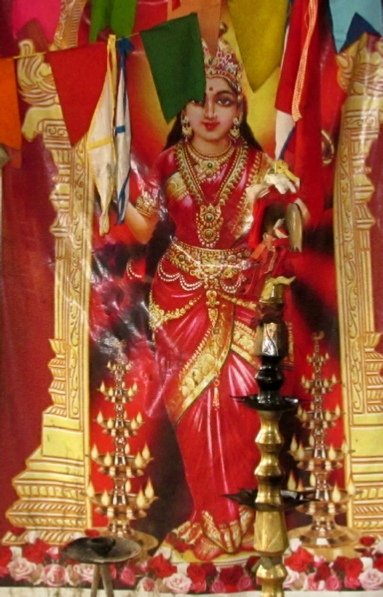
Image of the Deity Pattini
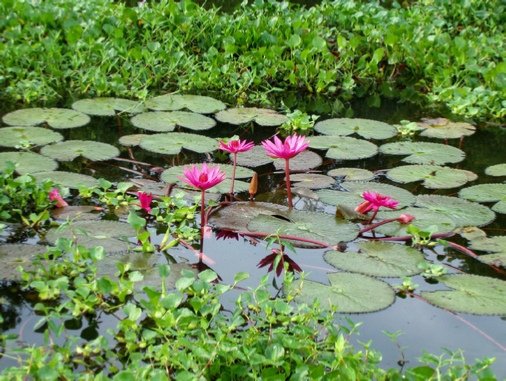
Water lily pond
However, the Deity Sakra took pity on the King in his agony, and while he was sleeping Sakra cut open the King’s skull removing the frogs from his brain. Sakra then healed up the wound. The king’s headaches lessened but he was still not completely headache free.
No one knew what to do so the King consulted an astrologer who advised him he must build a “hut” 60 arms lengths long and 30 arms lengths wide. To one side of the hut he must construct an offering shrine in the shape of a triumphal arch constructed in three parts. He then had to provide a pot made of gold -
The practices, dances, songs and mimes at the ceremonies to the Deities are based on this myth and the other traditions associated with Pattini, such as her seven re-
These Pattini Tovils are held as a “thank you” to Pattini for the release of an individual or a community from an affliction. These may be held annually following a vow from the sufferer or community made to Pattini when they were afflicted. These ceremonies may also be held as a “thank you” to the Deities for successful harvests.
According to Paul Wirz (1954 page 156-
According to Gananath Obeyesekere in “The Cult of the Goddess Pattini” there is evidence that this cult is becoming more popular and there are an increasing number of shrines to this goddess.
The Pattini Ceremonies I attended included two community based ones and one held at the family home of a clairvoyant to reinforce and strengthen his powers of fore-
Origin of Pattini Ceremonies
Paul Wirz outlines the origin of these Pattini ceremonies as follows:
King Sali-
One day when the king was admiring his lily pond, he saw a most beautiful lily flower that had just opened in the sunshine. He bent down to inhale the scent. He did not notice the frog sitting on the flower. The frog then leapt into his nostril working its way up into his brain. Here it gave birth to many other frogs. This caused the King to suffer from severe headaches and he was driven close to insanity by the agonising pain. No one could cure him.
Who is Pattini?
Pattini is the favourite Deity of Sri Lanka. She is revered throughout the island in shrines not only in her dedicated Temple but also in Pattini Shrines in both Buddhist and Hindu Temples.
Pattini Ceremonies
Pattini - the Deity of fertility
According to one myth she is believed to have introduced rice cultivation (rice being the staple food). She is also believed to promote fertility of the land and of people and livestock and has the power to restore the imbalances of nature that cause problems e.g. too much or too little of fire, air, water etc. Such imbalances in nature can cause drought, flooding etc. and their associated resulting diseases and problems to the community.
People visit her devales (shrines) housed in the Buddhist and Hindu Temples and devales to request her help if Deity displeasure is considered to be the cause of their problem (Deities are believed to have the power to inflict punishments in the form of bad luck, illnesses, epidemics, drought, floods, famine, epidemics etc. These punishments can be directed at individual transgressors or communities.
Like the other Deities, Pattini is attributed with responsibility for causing illnesses and epidemics -
When a Deity is divined as the cause of the problem, the Deities will be approached via the priest at the Deity’s shrine. Appropriate offerings and prayers will be made by the supplicant(s) to the appropriate Deity to release them from the trouble via the intercession of the shrine priest and a vow may be made by the supplicant(s) to the Deity that must be carried out on successful recovery on the removal of their problem. Typical vows are promises to make a gift to a Temple, go on Pilgrimage, feed poor people or travellers, walk on fire or undertake similar painful acts (this type of vow is especially prevalent on the Eastern side of the island, where particularly during Perahera season, supplicants may be seen e.g. suspended from hooks inserted into their body, rolling all the way on the ground in a procession etc.) In addition the supplicant(s) may make a vow to hold a ceremony for the entertainment of the Deities to show their gratitude to them.
Pattini Ceremonies
There are four main ceremonies held when Deities are diagnosed as causing illnesses or troubles or that are held in gratitude, after Pattini and other Deities have cured or healed the individual or community. In this case the individual or community is fulfilling the conditional vow to hold the ceremony made when they originally appealed to the Deity for assistance and release from the affliction. These ceremonies are called the dana or dane (alms-
According to Obeyesekere these ceremonies are based on 35 ancient ritual texts or songbooks that provide the format and incantations/hymns for these ceremonies.
During these ceremonies various stages involving consecrations, offerings and ritual are conducted by the main officiants and the dancers. These include the following :
The Conch offering
Offering of Lights
Offering of Bulat Leaves
Planting of the Festival Bough
Planting of the Torch of Time
In the ceremonies I observed these stages were probably incorporated into the performances of the main ceremony which include:
Planting of the Bough
Evening Demon Time
Consecration of the Officiant’s Robes
Offerings of Lights for the Deities
The Torch of Time
The Myth of the Birth of Kurumbara, Devol Deviyo and Kataragama
Ritual of the Ceremonial Archway -
Offering of Bulat Leaves
Divine Ornaments Ceremonially Brought Forth
The Anklets ceremonially brought forth
Songs of the Seven Pattini
Entry of Deity Seven Pattini
Offerings made to the Divine Ornaments.
The Drummers Perform in Honour of Pattini
The Dance of Lights
Blessings of the Anklets or Service of the Divine Ornaments
Oblation to the Sanni Demons
Planting the Torch of Time and Dressing up as Vahala
Fire Walking/Trampling Ritual
Offering of the Dawn Watch to the Kurumbara Demons
Spectacle to the Twelve Deities -
The Dance of Gara
Returning the Deities to their earthly abodes.
(Full details and explanations and translations of relevant Pattini Texts are included in “The Cult of the Goddess Pattini” by Ganeth Obeysekere. It should be noted that the ceremonies I observed were similar but not exactly the same as the ones he describes. This could be due to fact he was describing ceremonies conducted several decades earlier than those which I observed at the beginning of the twenty first century.)
These ceremonies are puja/offerings to the Deities to thank them for caring for the gam -
These Pattini ceremonies that I observed, were conducted by groups of Tovil Dancers with one – the leader -
Deities are invited to attend the sacred area consecrated especially for the ceremony by the officiants/priests. The anklets, jewellry etc of Pattini that are so carefully placed in the shrines by the main officiant are only handled by him. These are believed to be imbued with her essence and to have curative qualities. During the ceremony the leading officiant “becomes” Pattini. He and and the other dancers with their dances, mimes and songs enact the myths associated with Pattini, her life and seven re-
The Deities are believed to be present at the ceremony in their essence and in the opening parts of the ceremony when the various structures that contain the shrines dedicated to the Deities are blessed and consecrated, the Deities are invited by the Officiant to attend the ceremony to view the proceedings whilst resting in comfort on their sacred “couches” (the Shrines) whilst they are entertained, thanked and praised during the ceremony.
Appropriate offerings for the Deities consist of bulat leaves, flowers, lights/torches etc and are presented in specifically shaped, woven offering baskets and the Festival Boughs and torches.
At the conclusion of the ceremony, Deities are returned to their Earthly Abodes (their main shrines) from which they were invited to visit for the duration of the ceremony.
Further Detailed Reading on Pattini and Pattini Ceremonies
Main References:
Paul Wirz “Exorcism and the Art of Healing in Ceylon” p.156-
Gananath Obeyesekere “The Cult of the Goddess Pattini” -
Bruce Kapferer “A Celebration of Demons”
Plus on internet Wilapedia
A.G.S. Kariyawasam “The Gods & Deity Worship in Sri Lanka” (Source: The Wheel Publication No. 402/404, ISBN 955-
Medical System
The Universe is believed to be composed of five constituents :
space or emptiness
wind or air -
water -
Earth
fire -
Three of these constituents are associated with the body and if they are in imbalance then this needs to be corrected by Ayuvedic medicines with appropriate foods and/or to promote opposites e.g. if a problem is diagnosed as too much bile (fire), the illness needs treating/counteracting with cooling medicines associated with water. And the patient is advised to eat “cooling” foods.
In the Pattini Ceremonies this theory of the universe is reflected in the environment e.g. an excess of fire/heat leads to drought and hence famine and is believed to lead to epidemics associated with heat of e.g. smallpox and measles. An excess of water e.g. during the monsoon season leads to crop damage, floods, drownings, landslides and house collapses plus illnesses associated with too much phelgm/water -
The supplicant(s) then requests the assistance of Pattini to correct these imbalances in the body or the universe. The three “faults” of the Āyurvedic medical system (air/breath; fire/bile; water/phlegm) indicate the upset of human bodily well-
Pattini is known for the sacred anklets and bracelets she wears, amulets thought to have special curative powers that can rid people of such conditions as smallpox, chickenpox, whooping cough, measles, and mumps. She protects people from diseases and calamities, and her interventions promotes the restoration of natural balance, bringing timely rains and promoting fertility and the growth of vegetation. She represents maternity, purity, healing, and piety embodied in a feminine divine form.
Another game is the Coconut Game (Polkeliya). As with the Horn Game, there are two teams of men and youths This is a dangerous game and only skilled males participate, the rest are spectators supporting their teams. Villagers have collected the hard coconuts (about 100-
Water Cutting forms part of these ceremonies. This is carried out by the main officiant of the ceremony. (At the end of the Kataragama Perahera water cutting is performed as a final stage.) It too is to promote fertility. It is usually held in secret -
(See Section on Myths for the legends about these games.)
Ritual Fertility Games
Associated with these ceremonies there may also be ritual fertility games such as the Horn Game (Ankeliya) in which two teams of village men participate. Each team has a branch on the end of which is either a deer horn or the end is carved to look like a horn. The two teams push against each other trying to break the other’s horn. The team that wins is the one with the broken horn. The horn represents a penis and when it is broken it “proves” those men are fertile.
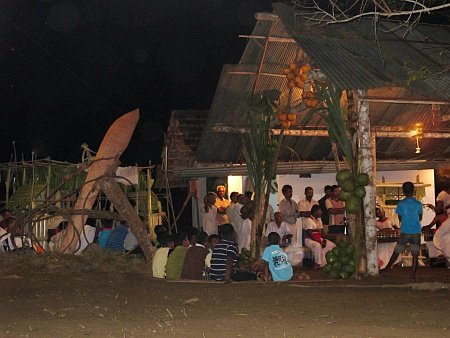
The “Horns” and ropes that had been used by the two competing teams earlier, on display at this Pattini Ceremony
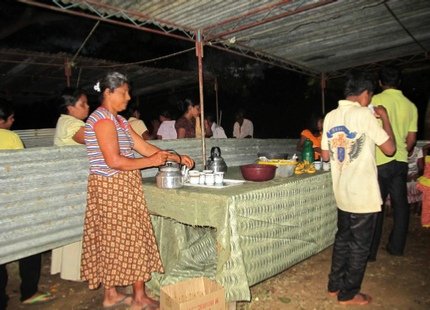
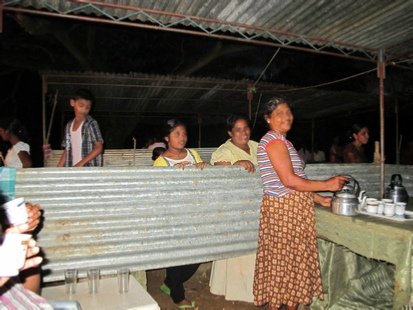
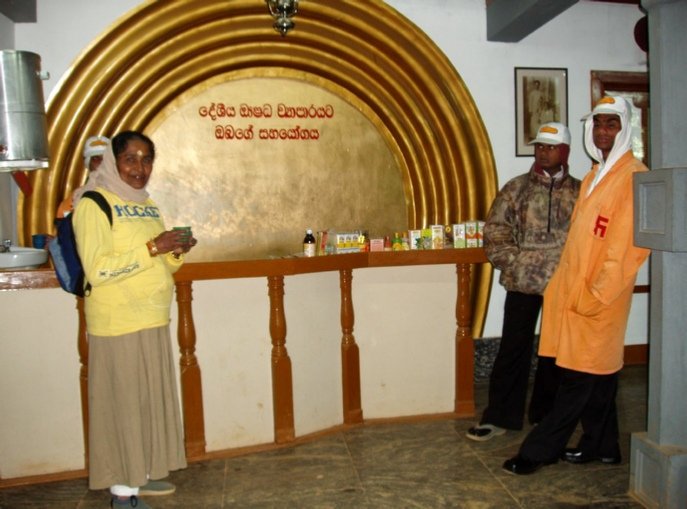
Serving and donating refreshments at a busy roadside to travellers
Serving pilgrims making night time ascent of Sri Pada (Adam’s Peak)
These Dana (alms giving) acts -